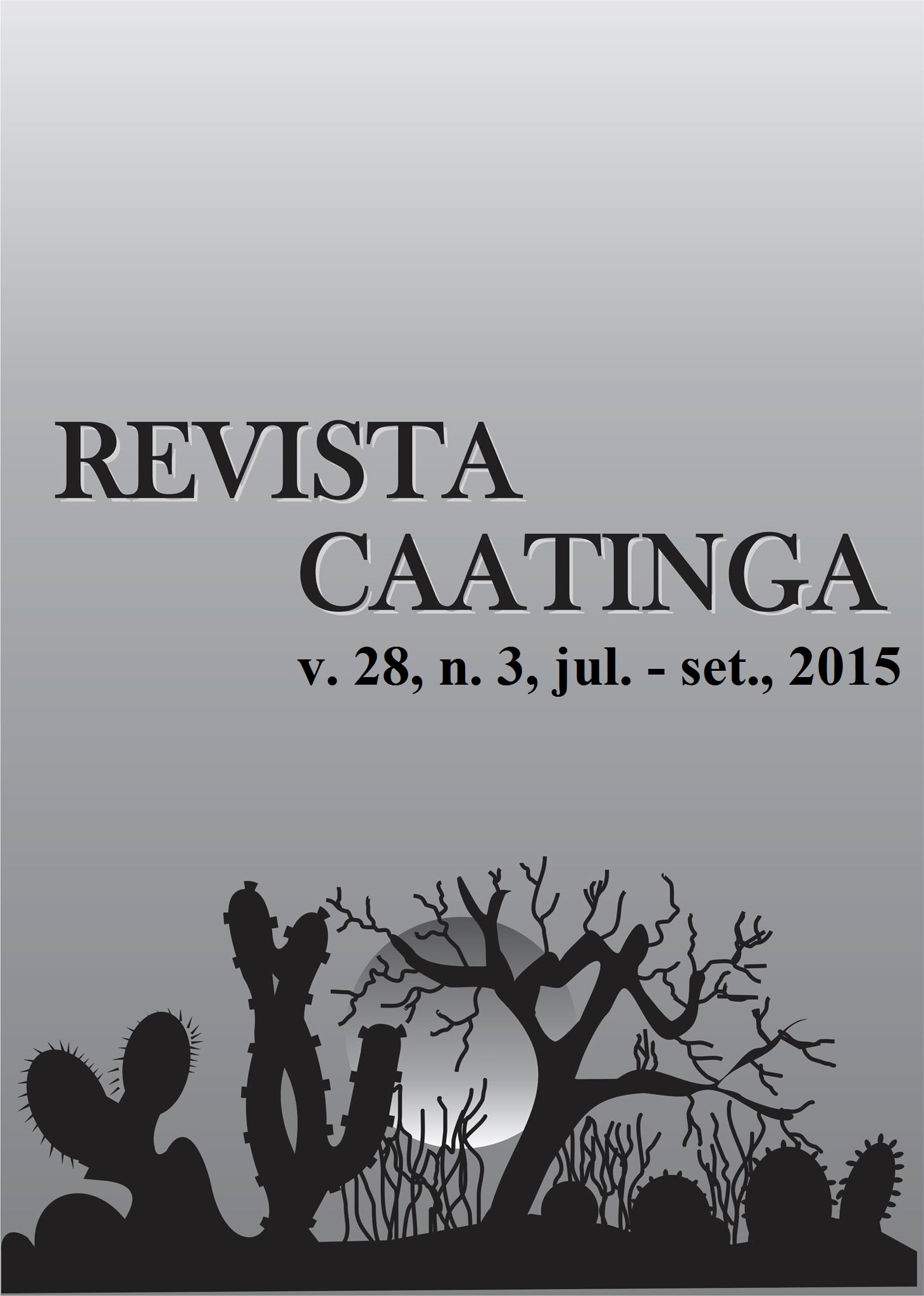RELAÇÕES ENTRE CARACTERES DE PIMENTÃO PROVENIENTES DE SEMENTES COM DIFERENTES NÍVEIS DE QUALIDADE FISIOLÓGICA
DOI:
https://doi.org/10.1590/1983-21252015v28n313rcPalavras-chave:
Capsicum annuum L. Análise de trilha. Vigor. Rendimento.Resumo
O objetivo deste trabalho foi identificar as relações entre as variáveis morfológicas e produtivas das plantas de pimentão provenientes de sementes com diferentes níveis de qualidade fisiológica. Os experimentos foram conduzidos em ambiente protegido na Universidade Federal de Santa Maria (UFSM), no delineamento blocos ao acaso, com oito repetições. Os tratamentos consistiram de três lotes de sementes do híbrido Tiberius e um lote da cultivar Rubi Giant nas estações de cultivo primavera-verão e outono-inverno, com diferentes níveis de qualidade fisiológica com base nos testes de germinação e vigor. Foram mensurados os seguintes caracteres (variáveis): altura de planta; altura da primeira bifurcação; diâmetro do caule; diâmetro do caule abaixo da primeira bifurcação aos 50, 70 e 90 dias após o transplantio; peso médio de frutos; produção média de frutos por colheita; produção total; comprimento médio de frutos; e largura média de frutos. A seguir, para cada nível de vigor, foi estimada a matriz de correlação de Pearson, o diagnóstico da multicolinearidade e, posteriormente, a análise de trilha, considerando a produção total de frutos como variável principal. As plantas obtidas a partir de sementes de vigor alto, médio e baixo, com maior diâmetro da primeira bifurcação aos 50 e 90 dias após o transplantio, são mais produtivas na estação de cultivo primavera-verão. No outono-inverno foram verificados coeficientes de correlação e efeitos diretos de baixa magnitude para todos os níveis de vigor, indicando fraca relação de causa e efeito das variáveis explicativas mensuradas sobre a produção total de frutos de pimentão.Downloads
Referências
CARGNELUTTI FILHO, A. et al. Número necessário de experimentos para análise de trilha em feijão. Ciência Rural, Santa Maria, v. 41, n. 4, p. 564-572, 2011.
CARVALHO, S. P. Métodos alternativos de estimação de coeficientes de trilha e índices de seleção, sob multicolinearidade. Viçosa: UFV, 1995. 163 p.
CARVALHO, C. G. P. et al. Análise de trilha sob multicolinearidade em pimentão. Pesquisa Agropecuária Brasileira, Brasília, v. 34, n. 4, p. 603-613, 1999.
CRUZ, C. D.; REGAZZI, A. J. Modelos biométricos aplicados ao melhoramento genético. 2.ed. Viçosa: UFV, 1997. 390 p.
CRUZ, C. D. GENES - a software package for analysis in experimental statistics and quantitative genetics. Acta ScientiarumAgronomy, Maringá, v. 35, n. 3, p. 271-276, 2013.
CRUZ, C. D.; CARNEIRO, P. C. S. Modelos biométricos aplicados ao melhoramento genético. 2.ed. Viçosa: UFV, 2006.v. 2. 585p.
CUTTER, E. G. Anatomia vegetal. Parte II. Orgãos-experimentos e interpretação. São Paulo: Roca Editora, 2002. 336 p.
DANTAS, M. R. S.; TORRES, S. B. Vigor de sementes de rúcula e desempenho das plantas em campo. Revista Brasileira de Sementes, Londrina, v. 32, n. 4, p. 49-57, 2010.
GAMIELY, S.; SMITTLE, D. A.; MILLS, H. A. Onion seed size, weight and elemental content affect germination an bulb yield. Hortscience, Alexandria, v. 25, n. 5, p. 522-523, 1990.
GOMES, R. L. F.; LOPES, A. C. A. Correlations and path analysis in peanut. Crop Breeding and Applied Biotechnology, Viçosa, v. 5, n. 1, p. 105-112, 2005.
GOULART, L. S.; TILLMANN, M. A. A. Vigor de sementes de rúcula (Eruca sativa L.) pelo teste de deterioração controlada. Revista Brasileira de Sementes, Londrina, v. 29, n. 2, p. 179-186, 2007.
KIKUTI, A. L. P.; MARCOS FILHO, J. Potencial fisiológico de sementes de couve-flor e desempenho das plantas em campo. Revista Brasileira de Sementes, Londrina, v. 29, n. 1, p. 107-113, 2007.
LÚCIO, A. D. et al. Variação temporal da produção de pimentão influenciada pela posição e características morfológicas das plantas em ambiente protegido. Horticultura Brasileira, Brasília, v. 24, n. 1, p. 31-35, 2006.
LÚCIO, A. D. et al. Relações entre os caracteres de maracujazeiro-azedo. Ciência Rural, Santa Maria, v. 43, n. 2, p. 225-232, 2013.
MAGUIRE, J. D. Speed of germination-aid in selection and evaluation for seedling emergence and vigor. Crop Science, Madison, v. 2, n. 1, p. 176-177, 1962.
MARCOS FILHO, J. Teste de envelhecimento acelerado. In: KRZYZANOWSKI, F. C.; VIEIRA, R. D.; FRANÇA NETO, J. B. (Ed.) Vigor de sementes: conceitos e testes. Londrina: ABRATES, 1999. p. 3.1-3.24.
MONTGOMERY, D. C.; PECK, E. A. Introduction to linear regression analysis. New York: John Wiley e Sons, 1982. 504 p.
SANTOS, C. M. R. et al. Alterações fisiológicas e bioquímicas em sementes de feijão envelhecidas artificialmente. Revista Brasileira de Sementes, Londrina, v. 26, n. 1, p. 110-119, 2004.
TOEBE, M.; CARGNELUTTI FILHO, A. Não normalidade multivariada e multicolinearidade na análise de trilha em milho. Pesquisa AgropecuáriaBrasileira, Brasília, v. 48, n. 5, p. 466-477, 2013.
VIEIRA, E. A.et al. Análise de trilha entre os componentes primários e secundários do rendimento de grãos em trigo. Revista Brasileira de Agrociência, Pelotas, v. 13, n. 2, p. 169-174, 2007.
WRIGHT, S.Correlationandcausation. Journal of Agricultural Research,Washington, v. 20, n. 7, p. 557-585, 1921.
WRIGHT, S. The theory of path coefficients – a replay to Niles’ criticism. Genetics, Austin, v. 52, n. 3, p. 239-255, 1923.
Downloads
Publicado
Edição
Seção
Licença
Os Autores que publicam na Revista Caatinga concordam com os seguintes termos:
a) Os Autores mantêm os direitos autorais e concedem à revista o direito de primeira publicação, com o trabalho simultaneamente licenciado sob a Licença Creative Commons do tipo atribuição CC-BY, para todo o conteúdo do periódico, exceto onde estiver identificado, que permite o compartilhamento do trabalho com reconhecimento da autoria e publicação inicial nesta revista, sem fins comerciais.
b) Os Autores têm autorização para distribuição não-exclusiva da versão do trabalho publicada nesta revista (ex.: publicar em repositório institucional ou como capítulo de livro), com reconhecimento de autoria e publicação inicial nesta revista.
c) Os Autores têm permissão e são estimulados a publicar e distribuir seu trabalho online (ex.: em repositórios institucionais ou na sua página pessoal) a qualquer ponto antes ou durante o processo editorial, já que isso pode gerar alterações produtivas, bem como aumentar o impacto e a citação do trabalho publicado (Veja O Efeito do Acesso Livre).







